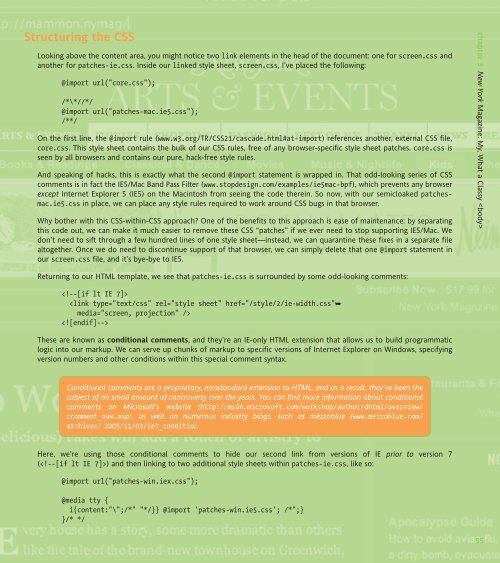WEB STANDARDS CREATIVITY
WEB STANDARDS CREATIVITY
WEB STANDARDS CREATIVITY
Create successful ePaper yourself
Turn your PDF publications into a flip-book with our unique Google optimized e-Paper software.
Structuring the CSS<br />
Looking above the content area, you might notice two link elements in the head of the document: one for screen.css and<br />
another for patches-ie.css. Inside our linked style sheet, screen.css, I’ve placed the following:<br />
@import url("core.css");<br />
/*\*//*/<br />
@import url("patches-mac.ie5.css");<br />
/**/<br />
On the first line, the @import rule (www.w3.org/TR/CSS21/cascade.html#at-import) references another, external CSS file,<br />
core.css. This style sheet contains the bulk of our CSS rules, free of any browser-specific style sheet patches. core.css is<br />
seen by all browsers and contains our pure, hack-free style rules.<br />
And speaking of hacks, this is exactly what the second @import statement is wrapped in. That odd-looking series of CSS<br />
comments is in fact the IE5/Mac Band Pass Filter (www.stopdesign.com/examples/ie5mac-bpf), which prevents any browser<br />
except Internet Explorer 5 (IE5) on the Macintosh from seeing the code therein. So now, with our semicloaked patchesmac.ie5.css<br />
in place, we can place any style rules required to work around CSS bugs in that browser.<br />
Why bother with this CSS-within-CSS approach? One of the benefits to this approach is ease of maintenance: by separating<br />
this code out, we can make it much easier to remove these CSS “patches” if we ever need to stop supporting IE5/Mac. We<br />
don’t need to sift through a few hundred lines of one style sheet—instead, we can quarantine these fixes in a separate file<br />
altogether. Once we do need to discontinue support of that browser, we can simply delete that one @import statement in<br />
our screen.css file, and it’s bye-bye to IE5.<br />
Returning to our HTML template, we see that patches-ie.css is surrounded by some odd-looking comments:<br />
<br />
These are known as conditional comments, and they’re an IE-only HTML extension that allows us to build programmatic<br />
logic into our markup. We can serve up chunks of markup to specific versions of Internet Explorer on Windows, specifying<br />
version numbers and other conditions within this special comment syntax.<br />
Conditional comments are a proprietary, nonstandard extension to HTML, and as a result, they’ve been the<br />
subject of no small amount of controversy over the years. You can find more information about conditional<br />
comments on Microsoft’s website (http://msdn.microsoft.com/workshop/author/dhtml/overview/<br />
ccomment_ovw.asp), as well on numerous industry blogs, such as mezzoblue (www.mezzoblue.com/<br />
archives/ 2005/11/03/ie7_conditio).<br />
Here, we’re using those conditional comments to hide our second link from versions of IE prior to version 7<br />
(















